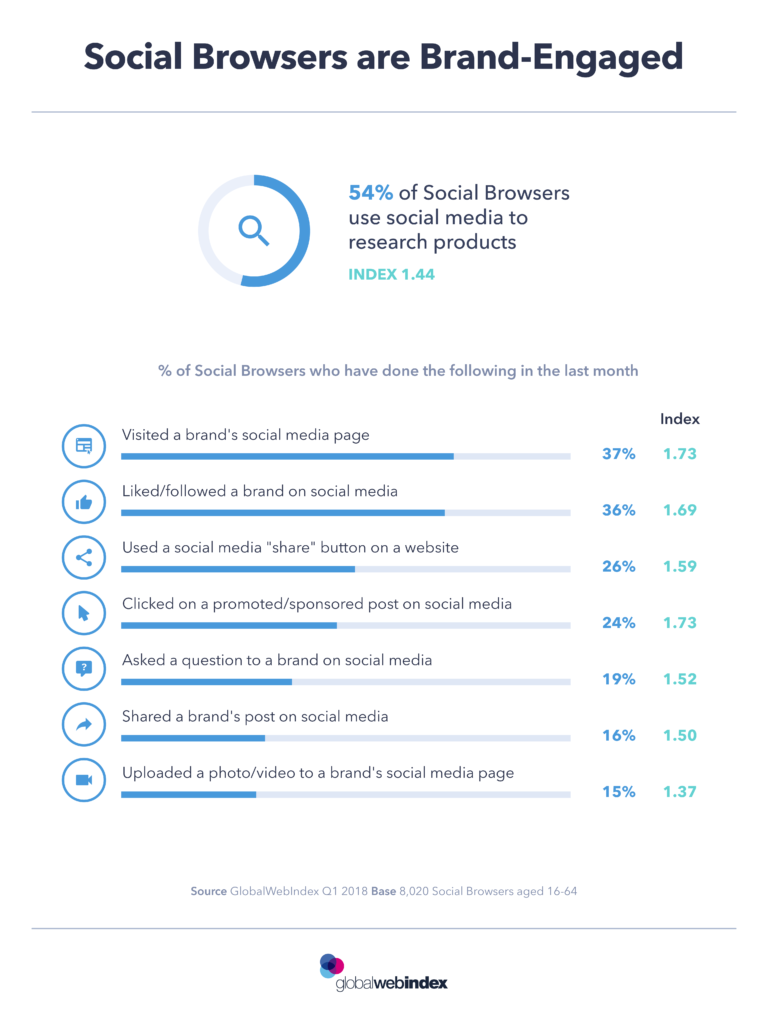Agree or not, social media listening is the most important component of a successful online strategy, especially when it is about improving one’s social media content and presence.
With the internet’s meteoric rise, content, both online and on social media has become cluttered than ever before. Businesses have flooded the internet with advertisements and promotions.
Every brand is attempting to capitalize on the latest trend! And by doing so, they’ve made the online spectrum increasingly complex.
The practice of listening to the online conversations surrounding your brand & competitors’ is an incredibly valuable practice you should not miss out on today!
In fact, 54% of social browsers use social media to research products.

That’s an opportunity you wouldn’t want to miss! You get more insights and learn how you can grow your business better!
Listening to social media has become the most important factor in developing a digital strategy. Monitoring, analyzing, and reacting are the three main steps in social listening.
In this read, we’ll tell you how you can improve your social media content strategy with the help of social listening. We’ll look into a bit of the basics and then proceed further!
What Is Social Media Listening?
Social listening is the process of analyzing conversations and trends on social media that aren’t only about your brand, but also about your industry and competitors. Then using that information, you can create better marketing strategies and decisions.
Social listening helps you identify where, why, and how customers are having conversations about your brand and not just instances when they mention or tag your brand to the post.
This empowers you to make informed decisions about future campaigns, improve your content strategy, outperform competitors and build a robust influencer program for impactful partnerships.
What’s the Difference Between Social Media Listening and Social Media Monitoring?
Knowing this is crucial because people often end up thinking both are the same!
The main difference between social listening and social media monitoring is the degree of information and insights you collect about your audience and competitors.
Social media listening targets what, where, how, and why. Whereas social media monitoring targets what and where!
To gain a better understanding of the difference between social listening and social media monitoring, here’s a quick read!
👉 Difference between social listening and social media monitoring
Now that we’re done with the basics, let’s look at what you’ve come here for!
How to Improve Your Content Strategy With Social Media Listening?
1. Analyze Customer’s Engagement with Social Media Content
Social listening will help you understand how customers engage with your posts and what type of content resonates and performs best with your audience.
The best way to identify what content will work for your brand and your audience is to test out different types of content. And based on the engagement and reaction from customers, you’ll know what content is guaranteed to perform well.
Reels, for example, are currently some of the most popular types of content consumed by customers.
Here’s an example for you!
Pepsi uses A/B testing to understand what their customers prefer. They are no stranger to controversial ads. One instance is when their 2017 campaign with Kendall Jenner received a lot of backlashes. Since then, they have been more conscious and have learned to include their audience when creating content.
Pepsi believes in working backwards! Using social listening, they gathered key insights about their consumers.
With the current situation they soon came to realise bottles that had an emoji to represent different moods would be a fun experience for customers at a time when people are uncertain about the future.
Pepsi started a #SayItWithPepsi campaign where they introduced bottles with emojis on them. Pepsi and Walgreens developed an influencer campaign, creating “social shops”, where influencers’ followers had a prominent call to action: to head to Walgreens and purchase the new exciting Pepsi bottle.

2. Identify and Leverage Your Brand Influencers
Who are the most prominent influencers and content creators that talk about your brand? What are they saying?
Your content strategy must identify influencers who talk about your brand. And social listening helps you with this! You can
-
Identify experts in your industry who have insightful opinions to improve your understanding of trends and market knowledge.
-
Choose social media influencers who can elevate your content and marketing efforts.
3. Monitor Competitors and Their Engagement
Tracking your competitors will show you
-
What type of content interests your audience
-
What kinds of content are being shared most
-
And what kind of content that’s not received well/flops.
Find and stay ahead of the curve by gaining insights about your competitors’ strategies, customer satisfaction and sentiments. By reviewing your competitor’s mentions and tags across platforms, you can identify what factors motivate your customers.
You can also identify the value proposition of your competitors and insights into their product development. Understanding why customers are attracted to another brand can help you adjust your strategy to match your customers’ needs.
4. Monitor Trends to Engage Customers
When you search for discussions concerning your brand and the industry at large, you will understand what content is most useful in terms of current trends.
By identifying the latest buzzwords and trends, you can include them in your post, adding hyperlinks to the best performing blog or article in your industry also boosts viewer engagement and sharing.
Example: Netflix does not hide its belief in the benefits of listening to social media. They have often spoken about their belief in identifying new trends, particularly those that are a source of inspiration.
Netflix used social listening for their latest content piece. They created a film that shows customers how they can make DIY socks as a direct reaction to the “Netflix and chill” trend.
5. Identify Prospective Customers
By using keyword-based tracking on social media, you can accurately identify conversations and bring potential customers to your products or services in a casual, engaging and timely manner.
Every company must know how to create leads and convert them to customers that return. Lifelong clients are not only good for your image but also transform others through free advertising of social media and word-of-mouth.
In addition, social listening can be used to identify and contact clients who are directly interested in your offering. This is known as social selling.
If you are interested in learning how to go about social selling, here is a quick read about the same!
👉5 mistakes to avoid while converting social media followers to sales.
Wrap Up
Now that you’re here, it’s understood that you’ve come across the 5 ways how social listening can help improve your content strategy. All you have to do is, follow the same, gain some insights and see how your content strategy can be tweaked accordingly!
Social listening helps you to deliver content to your customer that interests and resonates with them. Also, social listening provides you with accurate and comprehensive data instead of relying on your assumptions and feelings.
When you listen to your customers actively, review your competition and work with the best influencers in your industry, you can strengthen your brand image, products, and services. And yes, your content strategy is definitely going to be more effective.
